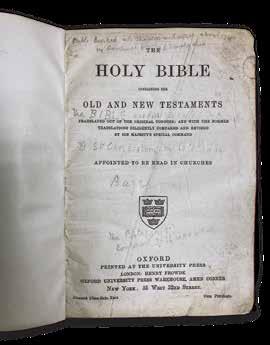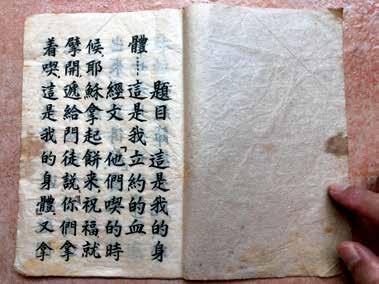
4 minute read
Home—A lasting legacy
The Rev Dr Andrew Peh is the Chairperson of the Council of Archives and History of The Methodist Church in Singapore. He is currently a faculty member at Trinity Theological College, teaching Missions and World Religions. His area of research is missions history in East and South East Asia, particularly Singapore, which is the focus of his published dissertation, Of Missions and Merchants. / Photos courtesy of the Methodist Archives and History Library
A lasting legacy
I
n the BBC series, A History of the World in 100 Objects, writer and presenter Neil MacGregor, who is also the British Museum director, commented that he was “travelling back in time, and across the globe, to see how we humans over two million years have shaped our world and been shaped by it, and I’m going to tell this story exclusively through the things that humans have made: all sorts of things, carefully designed, and then either admired and preserved, or used, broken and thrown away.” This novel approach of retelling history has also sparked a new initiative of teaching history with a partnership of the Department of Education in the United Kingdom. 1
It is in the same spirit of informing and showcasing our Methodist history that we have embarked on collecting some of the important objects that are pertinent in recounting the story of Methodism in Singapore. Some of the important and priceless artefacts include:
The Polglase Bible
John Polglase, a British Wesleyan, was one of the three potential lay candidates to hold office at the elections of the first Quarterly Conference held on 23 Feb 1885. Due to the absence of the other two candidates, Polglase was elected to all the offices that had to be filled


by laymen, including Sunday School Superintendent, trustee, steward and church treasurer! The Bible that Polglase used through his service is one of the most prized possessions of the Methodist Archives.

Telok Ayer Chinese Methodist Church bell
Telok Ayer CMC began in a shophouse in Upper Nankin Street that was converted into a place for Sunday worship services in 1889 by Dr Benjamin West, an American medical doctor and Methodist missionary. When the church was able to acquire land to build a more permanent building, a bell tower was included, where the bell would be rung to remind the predominantly Chinese labourers (and ex-opium addicts) to come for services.
The Rev C. E. Fang’s calligraphic notes
This comes from a personal family collection of the handwritten exhortation of “This is My Body, This is My Blood of the New Covenant” (based on Matthew 26). It is likely from the pen of the Rev Fang himself. Long before the ubiquitous printed or photocopied materials, handwritten portions of the Bible were often circulated in ensuring biblical literacy as well as doctrinal orthodoxy.

More than simply collecting and storing these artefacts, the undergirding principle is that our history is important and needs to be transmitted to future generations. It brings to mind the Reformers’ call of ad fontes (back to the sources) as well as the Chinese proverb, 饮水思源, that is, to give thoughtful consideration for the source of the water from which we drink.
Not unlike Israel, we are a forgetful people and we live in a context where theological amnesia and historical dementia are increasingly common. This underscores the relevance and the significance of the place and ministry of archives and history in both the local churches as well as in the Annual and General Conferences. Archives are akin to “raising an Ebenezer”—in 1 Samuel 7:12, Samuel took a stone and raised it as a memorial between Mizpah and Shen, to serve as a reminder of the great victory God gave to Israel, lest Israel forget God’s covenantal faithfulness. And like Ebenezers, archives serve as a reminder that “thus far the Lord has helped us”—lest we forget!
Chronicling history, collecting archival materials and conserving records are regrettably tasks and responsibilities about which not many are particularly enthused. Yet such historical myopia undoubtedly leads us to be ill-informed, impoverished and incapacitated.
It may well be that most people think of archives and history as matters that relate to the past. This perhaps creates a dissonance in appreciating the importance of archives. We need to understand that archives and history are NOT only about the past; they are about giving to and empowering posterity with a rich historical legacy.
Historian Jonathan Hill, in A History of Christian Thought, reminds us that “a society with no grasp of its history is like a person without a memory”. Elsewhere, Joanna Schwartz and Terry Cook write: Memory, like history, is rooted in archives. Without archives, memory falters, knowledge of accomplishments fades, pride in a shared past dissipates. Archives counter these losses. Archives contain the evidence of what went before. This is
particularly germane in the modern world. With the disappearance of traditional village life and the extended family, memory based on personal, shared story-telling is no longer possible; the archive remains as one foundation of historical

understanding. Archives validate our experiences, our perceptions, our narratives, our stories. Archives are our memories. 2
And more than merely refreshing fading memories and recounting past glories, these objects in our archives should catalyse and ignite a renewed vigour in living out the lasting legacy of the people called Methodists.

1
http://www.teachinghistory100.org 2 Joanna Schwartz and Terry Cook, “Archives, Records, and Power: The Making of Modern Memory,” Archival Science, See https://www.nyu.edu/classes/bkg/methods/schwartz.pdf vol. 2, nos. 1–2 (March 2002), 18.










